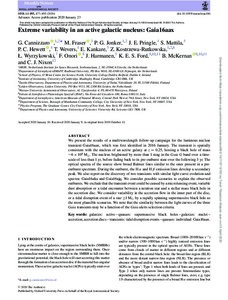Extreme variability in an active galactic nucleus: Gaia16aax
Cannizzaro G; Fraser M; Jonker PG; Pringle JE; Mattila S; Hewett PC; Wevers T; Kankare E; Kostrzewa-Rutkowska Z; Wyrzykowski L; Onori F; Harmanen J; Ford KES; McKernan B; Nixon CJ
Extreme variability in an active galactic nucleus: Gaia16aax
Cannizzaro G
Fraser M
Jonker PG
Pringle JE
Mattila S
Hewett PC
Wevers T
Kankare E
Kostrzewa-Rutkowska Z
Wyrzykowski L
Onori F
Harmanen J
Ford KES
McKernan B
Nixon CJ
OXFORD UNIV PRESS
Julkaisun pysyvä osoite on:
https://urn.fi/URN:NBN:fi-fe2021042823547
https://urn.fi/URN:NBN:fi-fe2021042823547
Tiivistelmä
We present the results of a multiwavelength follow-up campaign for the luminous nuclear transient Gaia16aax, which was first identified in 2016 January. The transient is spatially consistent with the nucleus of an active galaxy at z = 0.25, hosting a black hole of mass similar to 6 x 10(8) M-circle dot. The nucleus brightened by more than 1 mag in the Gaia G band over a time-scale of less than 1 yr, before fading back to its pre-outburst state over the following 3 yr. The optical spectra of the source show broad Balmer lines similar to the ones present in a preoutburst spectrum. During the outburst, the H alpha and H beta emission lines develop a secondary peak. We also report on the discovery of two transients with similar light-curve evolution and spectra: Gaia16aka and Gaia16ajq. We consider possible scenarios to explain the observed outbursts. We exclude that the transient event could be caused by amicrolensing event, variable dust absorption or a tidal encounter between a neutron star and a stellar mass black hole in the accretion disc. We consider variability in the accretion flow in the inner part of the disc, or a tidal disruption event of a star >= 1 M-circle dot by a rapidly spinning supermassive black hole as the most plausible scenarios. We note that the similarity between the light curves of the three Gaia transients may be a function of the Gaia alerts selection criteria.
Kokoelmat
- Rinnakkaistallenteet [27094]
